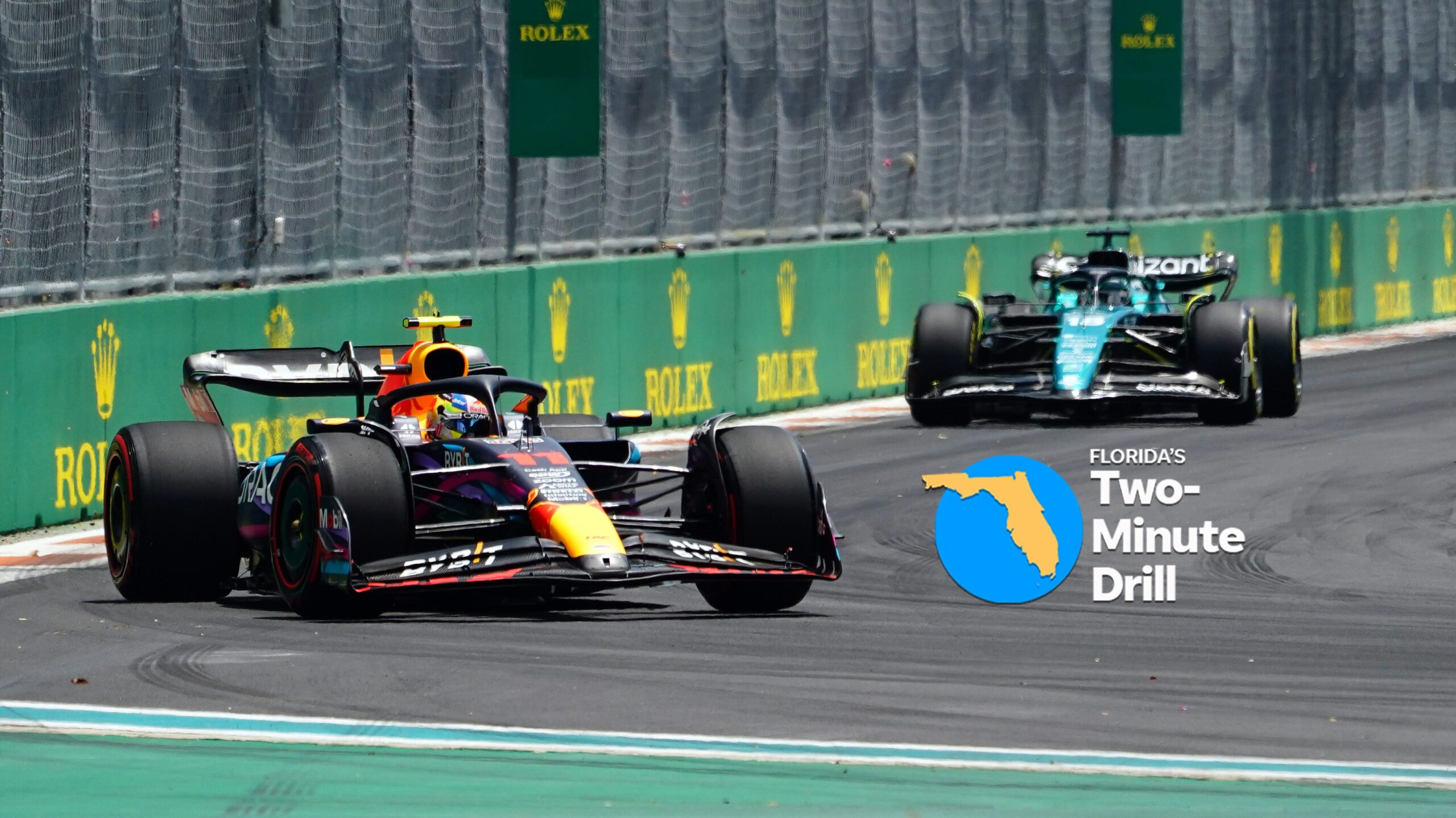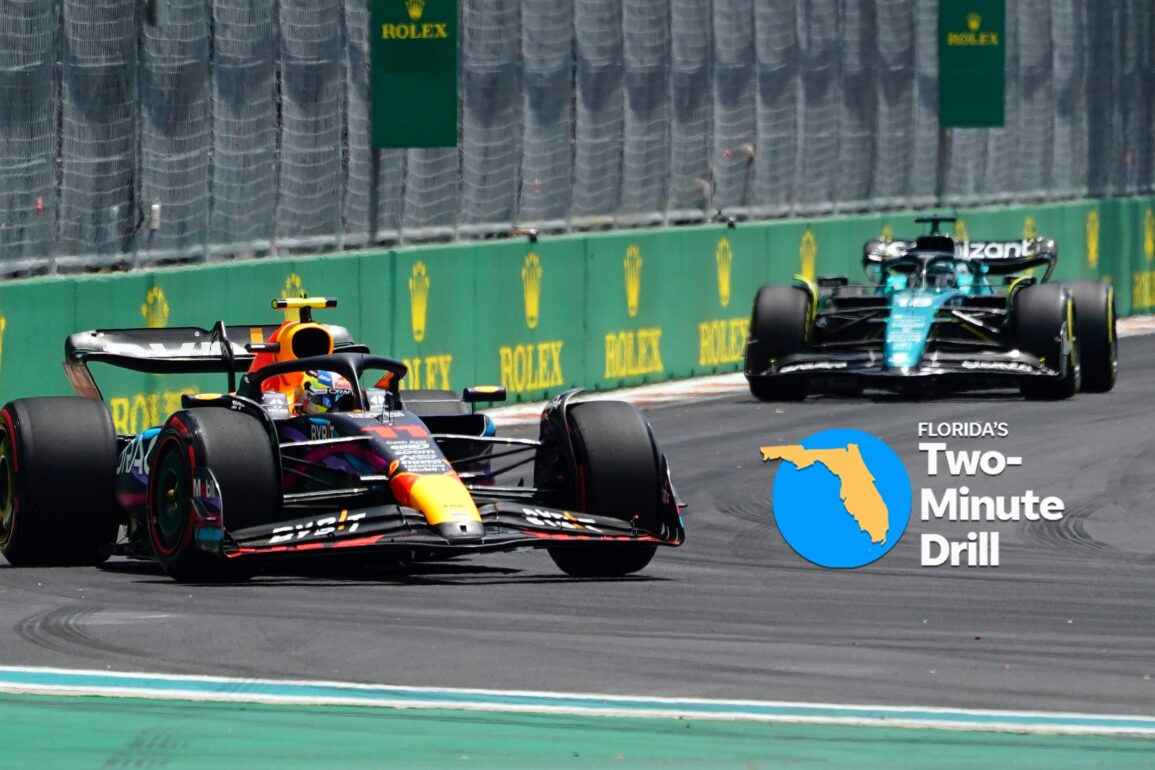
Two-Minute Drill: Miami Grand Prix and longtime columnist retires
The Miami Grand Prix will take place Sunday, May 4, at 4 p.m. at the Miami International Autodrome; Florida Times-Union columnist Gene Frenette retires.
Is President Donald Trump about to tackle Name, Image and Likeness (NIL)?
Trump is considering an executive order “that could increase scrutiny of the explosion in payments to college athletes since 2021, according to the USA TODAY.
Trump met with legendary football coach Nick Saban late last week during the president’s trip to Tuscaloosa to speak at the University of Alabama’s commencement ceremonies.
Saban, who won a record seven national championships as a college football coach, has been a vocal opponent of the way NIL has been implemented.
USA TODAY Florida Network recruiting reporters Jon Santucci and Nick Wilson discussed the idea of Trump potentially getting involved with NIL and what ideas they have to make things better.
Should President Trump get involved with NIL?
Santucci: Let me give a politician’s answer and not really answer the question. Yes, I think the government should get involved and help bring some much-needed regulation. The idea of needing congressional oversight into this issue isn’t a new idea and it’s probably overdue. Do I favor the idea of President Trump issuing an executive order to fix NIL? After seemingly one conversation with Nick Saban, who is all-time great coach but no friend of NIL? No. And this isn’t about party affiliation. I just don’t like the idea of a sweeping mandate that won’t have nearly enough input or study to fix things — no offense to whatever Saban told the president. This has to be better than Trump and Saban deciding the future of NIL.
Wilson: From the Trump administration’s perspective, I can see the appeal in stepping in and providing order to the lawlessness that is college recruiting. But it’s probably a fool’s errand. The NCAA has proven its inability to govern that arena for over a decade now, so the idea that a 100-day old administration can fix things with a sweeping mandate seems unrealistic. Could this be something that the administration sees as an easy win, and not the can of worms it truly is?
What’s the biggest problem concerning NIL?
Santucci: Not having a time machine. The problem is the NCAA, which spent years fighting the idea of NIL rather than figuring out the best way to implement it. So, now we have the wild, wild west and it’s going to be awfully tough to get things under control. And you have a joke of an organization pretending to police it. Look, NIL was long overdue and I’m all for student-athletes getting to benefit from NIL. But most of what we call NIL is really a paycheck to play a sport. The vast majority of athletes aren’t working with Nike, McDonald’s or even a local pizza joint. They’re getting paid to play. Not exactly the spirit of NIL. Other than that, it’s created too much of a Have’s vs. Have Not’s. It’s always going to be there, but the NCAA tournament was a prime example, it’s pay to win. Maybe it always has been, but not having Cinderella dancing made the tournament a little less exciting and the future a little more concerning.
Wilson: NIL has a nasty connotation around it now, and that largely because of the culture surrounding it. Players are treated as commodities, whose values are locked into whatever they are at that point in their lives. We expect players to behave a certain way when universities and coaching staffs get away with a lot behind the scenes. It’s seen as fair game to criticize a player that enters the transfer portal or decommits, but there is often much more to the story. Many of these 16- and 17-year-olds are growing up in homes that make less that $100,000 a year, and suddenly find themselves in the middle of a bidding wars that often conclude north of half a million dollars … and these schools know it. Money is hurled at these families like candy and then we are shocked that players act accordingly by following the money for as long as they can. The “problems” concerning NIL stem from the tidal wave of money that has flooded the market, and the people who sign the checks.
What’s one suggestion you would make to help fix NIL?
Santucci: I’m an idealist, so I’d like to try to tackle both NIL and the transfer portal at the same time. So here we go. First, I would like to see a set number for incoming freshman. Just like most professional sports have a set contract that isn’t up for negotiation. You sign, you get a certain amount. There should be incentives built into the contract, but that would curb a lot of the issues of the haves and the have nots and money determining recruiting. Second, I would mandate a two-year minimum agreement between the school and the athlete. You can’t transfer after your first year and a school can’t get rid of you. I’m old school and I’d love to see more programs actually have to build their programs through solid recruiting and development. If you leave before two years, you have to sit out a year. That’s where I would start. Base pay for the first two years — you can add to that number through legitimate NIL deals — and see if that makes things any better. I’m also in favor of figuring out how to make student-athletes school employees, if for no other reason than it would help with the tax situation for teenagers without a lot of financial literacy.
Wilson: The market needs a serious reset. It’s incredibly unfair for us (as sports fans) to criticize student-athletes for doing exactly what any normal person would do — make the most amount of money that you can for as long as you can. If you want to change NIL, shift the focus to the universities’ coffers. Find a way for schools to spend more responsibly like using long-term contracts like Jon suggests, or implementing a good ole fashioned salary cap with an emphasis on roster building. It’s not a player’s responsibility to turn down more money if it is available to them somewhere else, and with no salary cap, schools with deep pockets can just keep raising the price until they get their guy … year after year. If a program has a limited amount to spend, they have to think about signing high school recruits and retaining their core, which means less wads of cash to hurl at an unsuspecting Group of Five All-Conference player.
This post was originally published on this site be sure to check out more of their content.






